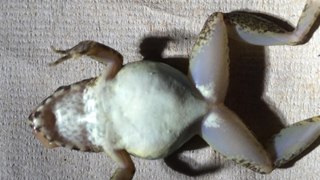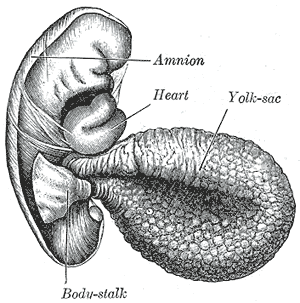
The amniotic sac, commonly called the bag of waters, sometimes the membranes, is the sac in which the fetus develops in amniotes. It is a thin but tough transparent pair of membranes that hold a developing embryo until shortly before birth. The inner of these fetal membranes, the amnion, encloses the amniotic cavity, containing the amniotic fluid and the fetus. The outer membrane, the chorion, contains the amnion and is part of the placenta. On the outer side, the amniotic sac is connected to the yolk sac, the allantois and, via the umbilical cord, to the placenta.
Frei, Frey, Frej, Freij, Freyr or Freÿr may refer to:

Ovoviviparity, ovovivipary, ovivipary, or aplacental viviparity is a mode of reproduction in animals in which embryos that develop inside eggs remain in the mother's body until they are ready to hatch. This method of reproduction is similar to viviparity, but the embryos have no placental connection with the mother and receive their nourishment from a yolk sac. In some species, this is supplemented by uterine secretions or other maternal provisioning.

Chlamydia trachomatis, commonly known as chlamydia, is a bacterium that can replicate only in human cells. It causes chlamydia, which can manifest in various ways, including: trachoma, lymphogranuloma venereum, nongonococcal urethritis, cervicitis, salpingitis, pelvic inflammatory disease. C. trachomatis is the most common infectious cause of blindness and the most common sexually transmitted bacterium.

Among animals which produce one, the yolk is the nutrient-bearing portion of the egg whose primary function is to supply food for the development of the embryo. Some kinds of egg contain no yolk, for example because they are laid in situations where the food supply is sufficient or because the embryo develops in the parent's body, which supplies the food, usually through a placenta. Reproductive systems in which the mother's body supplies the embryo directly are said to be matrotrophic; those in which the embryo is supplied by yolk are said to be lecithotrophic. In many species, such as all birds, and most reptiles and insects, the yolk takes the form of a special storage organ constructed in the reproductive tract of the mother. In many other animals, especially very small species such as some fishes and invertebrates, the yolk material is not in a special organ, but inside the ovum.

A rectovaginal fistula is a medical condition where there is a fistula or abnormal connection between the rectum and the vagina.

Immunohistochemistry (IHC) is the most common application of immunostaining. It involves the process of selectively identifying antigens (proteins) in cells of a tissue section by exploiting the principle of antibodies binding specifically to antigens in biological tissues. IHC takes its name from the roots "immuno", in reference to antibodies used in the procedure, and "histo", meaning tissue. Albert Coons conceptualized and first implemented the procedure in 1941.

The allantois is a hollow sac-like structure filled with clear fluid that forms part of a developing amniote's conceptus. It helps the embryo exchange gases and handle liquid waste.

The yolk sac is a membranous sac attached to an embryo, formed by cells of the hypoblast adjacent to the embryonic disk. This is alternatively called the umbilical vesicle by the Terminologia Embryologica (TE), though yolk sac is far more widely used. In humans, the yolk sac is important in early embryonic blood supply, and much of it is incorporated into the primordial gut during the fourth week of development.

Proctitis is an inflammation of the anus and the lining of the rectum, affecting only the last 6 inches of the rectum.
Venereology is a branch of medicine that is concerned with the study and treatment of sexually transmitted diseases. The name derives from Roman goddess Venus, associated with love, beauty and fertility. A physician specializing in venereology is called a venereologist. In many areas of the world, the specialty is usually combined with dermatology.

The hypoblast is a tissue type that forms from the inner cell mass. It lies beneath the epiblast and consists of small cuboidal cells.
Immunoglobulin Y is a type of immunoglobulin which is the major antibody in bird, reptile, and lungfish blood. It is also found in high concentrations in chicken egg yolk. As with the other immunoglobulins, IgY is a class of proteins which are formed by the immune system in reaction to certain foreign substances, and specifically recognize them.
The Prausnitz–Küstner test is an immunologic test formerly used by physicians to determine if a patient has an allergic reaction to a specific antigen. The test has been replaced by the safer skin prick test. The PK test involves transferring serum from the test subject to another healthy person, essentially using the second person as a mixing vessel for antibodies and antigen. This is a pathway for transmission of blood-borne ailments like Creutzfeldt–Jakob disease, AIDS, and others, which is why the test is no longer recommended. Or in simple words, a test for the presence of immediate hypersensitivity in humans; test serum from an atopic individual is injected intradermally into a normal subject; the normal subject is challenged 24–48 hours later with the antigen suspected of causing the immediate hypersensitivity reaction in the atopic individual.

Esthiomene is a medical term referring to elephantiasis of the female genitals. In the past the term has also referred to elephantiasis of the male genitalia.

Juvenile fish go through various stages between birth and adulthood. They start as eggs which hatch into larvae. The larvae are not able to feed themselves, and carry a yolk-sac which provides their nutrition. Before the yolk-sac completely disappears, the tiny fish must become capable of feeding themselves. When they have developed to the point where they are capable of feeding themselves, the fish are called fry. When, in addition, they have developed scales and working fins, the transition to a juvenile fish is complete and it is called a fingerling. Fingerlings are typically about the size of fingers. The juvenile stage lasts until the fish is fully grown, sexually mature and interacting with other adult fish.

Islet resident macrophages are the predominant myeloid cell of the pancreatic islets of langerhans.














